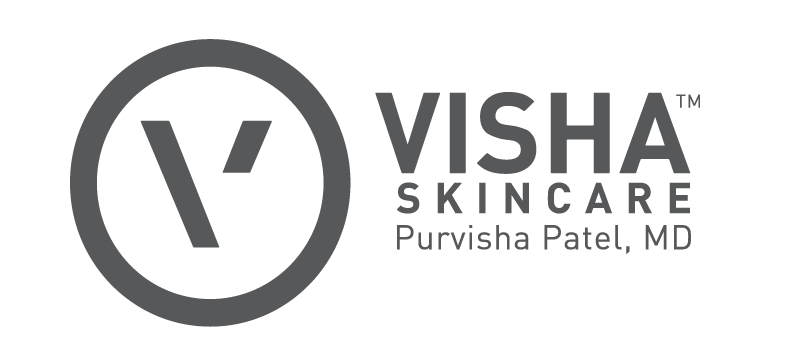
BYRDIE posted "Dermatologists Say This $15 Shampoo Could Clear Your Fungal Acne" and features Visha Skincare founder, Dr. Purvisha Patel's expert insights on fungal acne and Nizoral, including how to use it and best products that contain it.
Acne symptoms, like pimples or whiteheads, are caused by clogged pores, stuffed with extra oil, dead skin cells, and acne-causing bacteria. But what happens when your pores become clogged with yeast? A condition called pityrosporum folliculitis may pop up on your skin, which is otherwise known as fungal acne.1 Because these breakouts are caused by fungi rather than bacteria, traditional acne-fighting products will do very little to treat them, which can be incredibly frustrating and time consuming.
Instead, using anti-fungal products, like Nizoral, for acne will be your best bet at ridding your skin of unwanted bumps.
We spoke with Joshua Zeichner MD, Director of Cosmetic and Clinical Research in Dermatology at Mount Sinai Hospital in NYC, board-certified dermatologist and founder of Visha Skincare, Purvisha Patel, MD, and New York Celebrity Facial Surgeon Konstantin Vasyukevich, MD, to find out what fungal acne is, and how Nizoral can help.
Fast Facts: NIZORAL
TYPE OF INGREDIENT: Anti-fungal
MAIN BENEFITS: Treats fungal infections, reduces the overgrowth of fungus, prevents fungal acne.
WHO SHOULD USE IT: Anyone struggling with fungal acne, regardless of skin type.
HOW OFTEN CAN YOU USE IT: Every day, or every other day, for two to three weeks, in which time you should see improvement. If your condition clears up, use it twice weekly as a maintenance medication. If you haven’t seen changes in two to three weeks, you likely won’t, and should talk to your doctor about other treatment options.
WORKS WELL WITH: Salicylic acid and beta hydroxy acid
DON'T USE WITH: Oily moisturizers or topical antibiotics
What Is Nizoral?
"Nizoral is a brand name anti-fungal medication called ketoconazole," says Joshua Zeichner MD, Director of Cosmetic and Clinical Research in Dermatology at Mount Sinai Hospital in NYC. "It lowers levels of fungus on the skin and is commonly used to treat conditions like dandruff and athlete's foot. It is also used to treat pimples when they are resistant to other therapies."
Benefits of Nizoral for Acne
Anyone who’s experienced acne symptoms may easily mistake fungal acne for bacterial acne, which isn’t surprising as they can look similar, each resulting in texture on or just under the surface of the skin.
- Treats fungal acne: If you’re struggling with stubborn acne symptoms that don’t seem to budge using products marketed to treat acne, you may find some relief with anti-fungal products like Nizoral with the help of your doctor. "Overgrowth of fungus (yeast) is an often overlooked cause of skin acne," says New York Celebrity Facial Surgeon Dr. Konstantin Vasyukevich. "It targets a type of acne that would not improve with regular antibiotics, and might require anti fungal treatment."
Benefits of Nizoral for Skin
- Treats dandruff: Nizoral is, quite simply, a dandruff treatment shampoo that's used on areas of the face and body to treat fungal acne. So, if you have dry, flaky skin on your scalp, Nizoral may help.
- Treats athlete's foot: Dandruff isn't the only fungus-caused condition that Nizoral can treat. Conditions like athlete's foot and even ringworm may be improved with once or twice daily use of Nizoral—just be sure to dry any treated areas well, as fungus thrives in warm, humid climates.
Side Effects of Nizoral
While Nizoral is considered an effective way to combat fungus, there is a potential risk of side effects, just like any medication. A common side effect of Nizoral is itching or the development of a rash on or around the area that’s been treated. Additionally, some people may experience nausea, dizziness, stomach pain, and headaches. If you’re pregnant, nursing, or planning a pregnancy, talk with your doctor before taking Nizoral as it may contaminate breast milk, which can be harmful.
How to Use It
First thing’s first—you’ll need to confirm that what you’re aiming to combat is, in fact, fungal acne, which is a condition of its own. "There is a condition called pityrosporum folliculitis that is caused by the fungus that causes dandruff," explains board-certified dermatologist and founder of Visha Skincare, Dr. Purvisha Patel. "Overgrowth of this organism on the scalp can spill down onto the forehead, hairline, face, behind the ears and down the back. It presents as small bumps on the skin and even tiny clogged pores." Instead of bacterial acne, fungal acne, or pityrosporum folliculitis, occurs when yeast is trapped inside pores. "Any person whose acne is caused by fungus (yeast) could benefit from using Nizoral," Vasyukevich adds.
Using Nizoral is simple to execute, and can be easily added to your usual skin and body care routine.” I typically recommend using it daily in the shower for two weeks or so or until the pimples improve,” Zeichner suggests. "After that, I have my patients use it twice a week as maintenance. Because it comes as a shampoo, I tell my patients to use it like a liquid cleanser. It is important to get enough contact time on the skin for it to do its job, so you should apply, lather and count to 30 before rinsing off."
If you do have fungal acne, Nizoral is usually effective in a matter of weeks, but if you aren’t seeing signs of improvement just under the one month mark, finding a different solution will likely be needed to experience results. "One can apply Nizoral every other day, but if the acne is not showing improvement after 2-3 weeks further use of this medication is unlikely to be successful," says Vasyukevich.
The Best Products with Ketoconazole
Nizoral is the brand name of a product, so using this shampoo is always an option for treating fungal acne.
